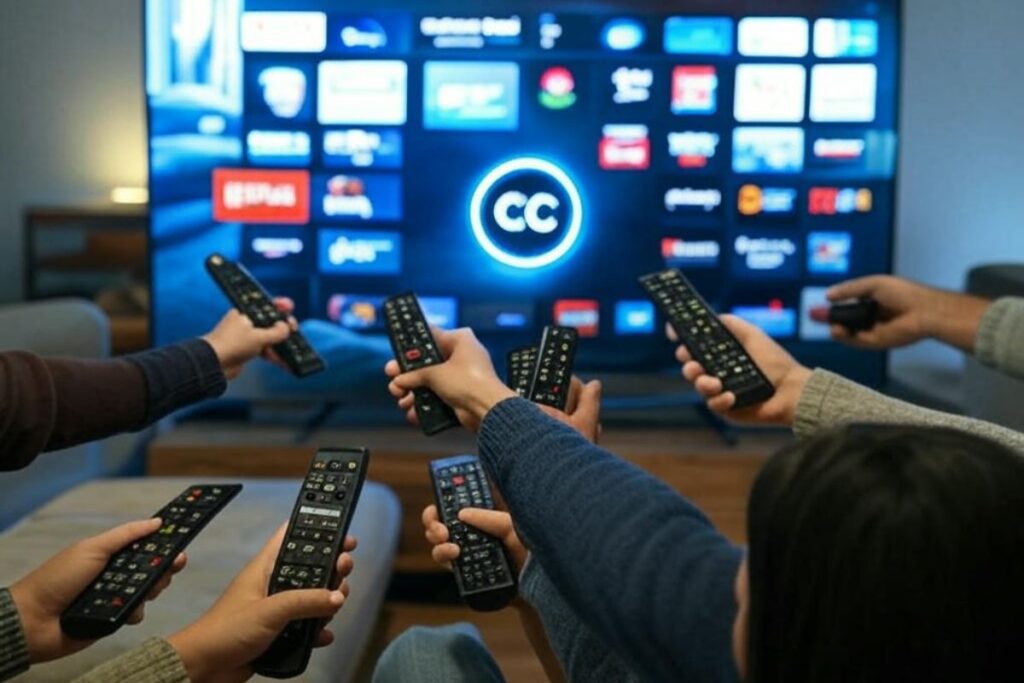If you’ve ever fumbled with your remote trying to turn on captions while binge-watching your favorite show, you’re not alone. In 2025, streaming services like Netflix, Amazon Prime Video, and YouTube TV dominate our screens, but their inconsistent caption controls are driving viewers up te wall.
With 63% of Americans under 30 preferring subtitles—according to a 2023 YouGov survey—the demand for easy-to-use closed captioning is louder than ever. So why is something as simple as turning on captions still a tech nightmare? Let’s dive into the mess, explore why it matters, and figure out how streaming giants can fix it.
The Caption Craze: Why We Love Subtitles in 2025
Picture this: you’re watching a gritty British crime drama, and the thick accents leave you guessing half the dialogue. That’s where captions swoop in to save the day. For many, like me, subtitles started as a way to decode tricky accents but quickly became a habit.
Now, I can’t watch TV without them—whispered lines, background chatter, every nuance pops off the screen. And I’m not alone. That 2023 survey showed younger viewers are hooked, with streaming platforms reporting a surge in subtitle use over the past two years.
Read Also: Nothing Phone (3a) Debuts at $414: Glyph Lights and Bold Design Aim to Shake Up 2025 Smartphones
But here’s the rub: each streaming service has its own quirky way of handling captions. Whether you’re on Netflix or wrestling with YouTube TV’s labyrinthine menus, turning on subtitles feels like a mini tech puzzle. It’s 2025—shouldn’t this be simpler? As streaming technology evolves with AI-driven features and 4K visuals, the caption conundrum feels like a stubborn relic of the past.
A Tour of Caption Chaos: How Top Streaming Services Stack Up
Let’s break down the subtitle struggle across some of the biggest names in streaming. I tested these on an Apple TV setup—fair warning, your mileage might vary with Roku or Chromecast—but the frustration is universal.
Netflix: The Gold Standard (Sort Of)
On Netflix, it’s pretty straightforward. Start a show, and a speech bubble icon pops up in the bottom right. Swipe up with your remote, tap it, and boom—captions are on. It’s intuitive, clean, and quick. Maybe it’s because I’ve been a Netflix loyalist for years, but this feels like the benchmark. Still, even here, I’ve accidentally paused a thriller mid-climax hunting for that bubble.
Amazon Prime Video: Proceed with Caution
Prime Video? Swipe up to open the menu, and you’ll spot “subtitles” in the lower left. Sounds easy, right? Not so fast. Lurking nearby is the dreaded “play from beginning” button—a trap that’s restarted my episode more times than I’d like to admit. Then there’s the “on/off” toggle—confusingly vague. Is it already on? Do I want it on? Good luck figuring it out without a misstep.
Disney+: A Paragraph of Pain
Disney+ takes a different tack. Swipe down, and a menu drops from the top with audio and subtitle options. Instead of a neat dropdown, you get a paragraph-style list of languages. Scroll to “English [CC]” (closed captions), select it, and you’re set. It’s not hard, just oddly clunky for a platform known for sleek design.
Max: Simple, If You Find It
Max keeps it basic. Swipe up, tap the speech-bubble icon at the bottom right, and a subtitle menu appears. It’s self-explanatory once you’re there, but finding that icon mid-show can still trip you up. I’ve exited episodes entirely while fumbling for it.
Peacock: Dodge the Restart
Peacock’s setup is a bottom-left menu—swipe up, and you’ll see “subtitles and audio.” But watch out: “restart” and “next episode” buttons are right next door, ready to derail your viewing. It’s a small hurdle, but one misclick, and you’re back to square one.
Apple TV+: Netflix’s Twin
Apple TV+ mirrors Netflix closely. Swipe to a bottom menu, pick subtitles from a list, and you’re golden. There’s an extra “minimize screen” button that’s thrown me off a time or two, but otherwise, it’s smooth sailing.
YouTube TV: A Descent into Madness
Then there’s YouTube TV. Swipe down too fast, and you’re stuck in a “more to watch” thumbnail grid. Swipe lightly back up—but not too far—or you’ll exit the menu. Scroll left through a maze of options to find the “CC” button, then tap it for a submenu. It’s a chaotic dance that feels like it was designed to test your patience. Hell is real, and it’s this interface.
Why Captions Matter More Than You Think

Sure, I’m a hearing person who just likes captions for clarity, but for millions, they’re a lifeline. Closed captioning is an accessibility cornerstone—vital for the deaf and hard of hearing. Meredith Patterson, president of the National Captioning Institute, told me she’s thrilled to see subtitles go mainstream. “We want closed captioning to be the norm, and we’re committed to making that happen,” she said. With AI improving caption accuracy and speed in recent years, the tech is there—so why isn’t the user experience keeping up?
For someone who relies on captions, wrestling with inconsistent menus isn’t just annoying—it’s a barrier. Imagine missing the plot twist of a 2025 blockbuster because you can’t find the “CC” button. It’s not just a quirk; it’s a failure of design.
The Tech Behind the Trouble: Why So Different?
Streaming services love to flex their unique identities. Netflix’s slick interface, Disney+’s family-friendly polish, YouTube TV’s live-TV chaos—each platform wants to stand out. That’s fine for branding, but it’s a headache for basic functions like captions. In 2025, when AI can generate subtitles in real-time with near-perfect accuracy, shouldn’t accessing them be as standardized as a website’s “contact us” link?
Think about it: we expect privacy policies at the bottom of a page, notifications in a social app’s top corner. Why can’t streaming platforms agree on a universal caption shortcut? They’re all committed to offering subtitles—once you crack the code, they work—but the journey there is a mess.
How Streaming Services Could Fix This in 2025
Here’s the good news: this isn’t hard to solve. AI captioning tech is already top-notch, and streaming giants have the resources to streamline their interfaces. A few ideas:
- Universal Shortcut: A standard remote gesture—like a double-tap or long press—to pull up captions across all apps.
- Consistent Menus: Place subtitle controls in the same spot (say, bottom right) on every platform.
- Voice Commands: Lean on 2025’s voice tech—say “turn on captions” to your remote and skip the fumbling.
These tweaks wouldn’t erase each service’s personality; they’d just make life easier for viewers. Imagine watching your favorite sci-fi series on Netflix, then switching to a live game on YouTube TV, all without relearning caption controls. It’s not rocket science—it’s user-friendly design.
The Bigger Picture: Accessibility Meets Convenience
This caption chaos isn’t just a personal pet peeve—it’s a microcosm of how tech can overlook the little things. Streaming services are pouring billions into 4K content, interactive features, and AI recommendations (looking at you, Netflix algorithm). Yet a feature as fundamental as subtitles feels like an afterthought. In 2025, with accessibility awareness at an all-time high, that’s a miss.
For small businesses or content creators using these platforms, it’s a reminder too: user experience matters. If your audience can’t navigate your tech—whether it’s a streaming app or your website—they’ll bounce. Consistent, intuitive design isn’t just nice to have; it’s a competitive edge.
What’s Next for Streaming Captions?
The rise of subtitle-loving viewers isn’t slowing down. As Gen Z and Millennials shape entertainment trends, expect captions to stay “the norm,” as Patterson hopes. Streaming services like Disney+, Max, and Amazon Prime Video have the chance to lead the charge—standardize caption access, and they’ll win over millions of frustrated fans. Competitors like Peacock and YouTube TV could follow suit, turning a pain point into a selling point.
Will 2025 be the year streaming finally gets captions right? I reached out to the big players for comment, but they stayed silent. Maybe they’re too busy perfecting their next AI feature. Until then, I’ll keep fumbling with my Apple TV remote—and accidentally restarting episodes.
Read Also: Canva’s AI Revolution Unveiled: Graphic Design Made Simple in 2025
Your Turn: How Do You Handle Captions?
Are you a subtitle superfan or just here for the chaos? How do you navigate captions on your favorite streaming service? Drop your tips—or horror stories—in the comments. Let’s figure out if there’s a secret handshake to make this easier, or if we’re all just doomed to swipe blindly into 2026!

